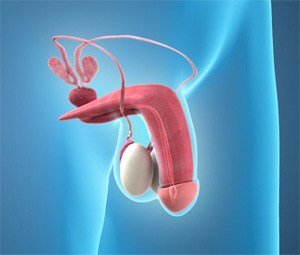
What is Erectile Dysfunction?
Erectile dysfunction, or ED, can refer to a decreased ability to achieve an erection firm enough for satisfactory sexual intercourse. This is different from premature ejaculation, when you do get an adequate erection but ejaculate more rapidly than desired. In older men, ED usually has an underlying physical cause, such as chronic illness, injury or side effects of drugs. Any disorder that causes injury to the nerves or impairs blood flow in the penis has the potential to cause ED. ED is more common as men age; about 5 percent of 40-year-old men, whilebetween 15 and 25 percent of 65-year-old men experience ED. Erectile dysfunction is not an inevitable part of aging.
How Does An Erection Occur?
Erections occur through a regulated process. Damage to any step can cause erectile dysfunction.
- Desire is felt. This may be accompanied by or caused by physical, verbal, or visual stimulation.
- The brain sends a signal through the spinal cord and the parasympathetic nervous system to the penis, causing release of nitrous oxide, a potent chemical that relaxes blood vessels.
- The blood vessels of the penis relax, causing blood to pool within the penis and increasing its size.
- As the blood vessels relax, the veins that drain the penis are closed, similar to bending a garden hose, and blood flow out of the penis stops.
- The arteries that bring blood into the penis continue to pump blood into the penis, increasing the pressure and causing a full, hard erection.
- Squeezing of the muscles around the base of the penis further increase the pressure inside the penis.
Coordination of the nerves, blood vessels, and muscles involved in this process are all essential for good erections.
What is the Difference Between Erection, Ejaculation, and Orgasm?
In a patient without erectile dysfunction, the link between erection, ejaculation, and orgasm is tightly connected. However, each of these events are controlled by different parts of the body.
Erection: The increase in size and hardness of the penis
Ejaculation: The emission of semen from the penis
Orgasm: The pleasurable sensation felt during ejaculation.
Men with erectile dysfunction can have ejaculation and orgasms without erections, and treatments for erectile dysfunction do not have a direct effect on ejaculation and orgasm. Some men experience ejaculation without orgasm, or orgasms without ejaculation.
Is Erectile Dysfunction Treatable?
ED is treatable regardless of how old you are. More men have been seeking help and returning to normal sexual activity because of improved, successful treatment of ED.
Since an erection requires a precise sequence of events to occur in your body, ED can occur when any of the events is disrupted. The sequence of events includes the generation of nerve impulses in the brain, spinal column, area around the penis, and response in muscles, fibrous tissues as well as vasculature in and around the corpora cavernosa. Causes of ED include the following:
- Diseases: Diseases such as diabetes, kidney disease, chronic alcoholism, multiple sclerosis, atherosclerosis, vascular disease, and neurologic disease account for about 70 percent of ED cases. Between 35 and 50 percent of men with diabetes experience ED. Low testosterone is often found in men with erectile dysfunction but has not been proven to be a cause of ED.
- Lifestyle Choices: Lifestyle choices that contribute to heart disease and vascular problems also increase the risk of erectile dysfunction. Smoking, obesity and a sedentary lifestyle are possible causes of ED.
- Surgery: Surgery (especially surgeries for prostate and bladder cancer) can injure nerves and arteries near the penis, causing ED. Injury to the penis, spinal cord, prostate, bladder, and pelvis can lead to ED by harming nerves, smooth muscles, arteries and fibrous tissues of the corpora cavernosa.
- Medications: Many commonly used medicines such as antihypertensive drugs, antihistamines, antidepressants, tranquilizers, appetite suppressants, and cimetidine (a drug used in the management of peptic ulcer) can produce ED as a side effect.
- Psychological Factors: Experts believe that psychological factors such as stress, anxiety, guilt, depression, low self-esteem, and fear of sexual failure cause 10 to 20 percent of ED cases. Men with a physical cause for ED frequently also experience some sort of psychological reactions (stress, anxiety, guilt, and depression).
- Smoking: Other possible causes of ED are smoking, which affects normal blood flow in the veins and arteries.
- Hormones: Hormonal abnormalities, such as low levels of testosterone, high levels of prolactin, or other dysfunction of the organs of the endocrine system can be related to ED.
Diagnosis of Erectile Dysfunction
The diagnosis of erectile dysfunction (ED) involves the following steps:
- Patient History: Medical and sexual histories help define the degree and nature of ED. A medical history can disclose diseases that lead to ED, while a simple recounting of sexual activity might distinguish among problems with sexual desire, erection, ejaculation or orgasm. Standardized questionnaires, such as the Sexual Health Inventory for Men (SHIM) can help to track response to treatment or lifestyle changes. Using certain prescription or illegal drugs can suggest a chemical cause since drug effects account for 25 percent of ED cases. Cutting back on or substituting certain medications can often alleviate the problem.
- Physical Examination: A physical examination can give clues to systemic problems. For example, if the penis is not sensitive to touch, it may indicate a problem in the nervous system. Abnormal secondary sex characteristics, such as hair pattern or breast enlargement, can point to hormonal problems, which would mean that the endocrine system is involved. The examiner might discover a circulatory problem by observing decreased pulses in the wrist or ankles. Unusual characteristics of the penis itself could suggest the source of the problem, for example, a penis that bends or curves when erect could be the result of Peyronie's disease (scar tissue of the pneis).
- Laboratory Tests: Several laboratory tests can help diagnose conditions that can cause erectile dysfunction. Tests for systemic diseases include blood counts, urinalysis, lipid profile, and measurements of creatinine and liver enzymes. Measuring the amount of testosterone or other hormones in the blood can yield information about problems with the endocrine system and is indicated especially in patients with decreased sexual desire.
- Other Tests: Rarely, other types of tests will be performed for evaluation of erectile dysfunction. Your doctor can discuss this with you depending on your specific circumstances.
- Psychosocial Examination: A psychosocial examination, using an interview and a questionnaire, reveals psychological factors. A man's sexual partner may also be interviewed to determine expectations and perceptions during sexual intercourse.
Non-surgical Treatment of Erectile Dysfunction
Erectile dysfunction (ED) can be treated by employing conservative or non-surgical methods and surgical methods. Conservative treatment measures to treat erectile dysfunction are always considered before invasive measures such as surgery.
Some conservative treatment measures include the following:
Lifestyle Changes: For some men, making a few healthy lifestyle changes may solve the problem. Abstinence from smoking, weight loss, and increased physical activity may help some men regain sexual function.
Medication Changes: The next step is cutting back on any drugs with harmful side effects. For example, drugs for high blood pressure work in different ways. If you think a particular drug is causing problems with erection, tell your doctor and ask whether you can try a different class of antihypertensive medicine.
Psychotherapy: Experts often treat psychological factors for ED using techniques that decrease the anxiety associated with the intercourse. The patient's partner can help with the techniques, which include gradual development of intimacy and stimulation. Such techniques also can help relieve anxiety when ED from physical causes is being treated.
Oral Therapy: Four different medications are currently available in oral forms to treat erectile dysfunction. Sildenafil (Viagra), Tadalafil (Cialis), Vardenafil (Levitra), and Avanafil (Stendra). Sildenafil, Vardenafil, and Avanafil are fast acting medications that are taken 45 minutes to 1.5 hours before an erection is desired. They should be taken on an empty stomach. Tadalafil may be used as a fast acting medication, taken several hours before and erection is desired, or it can be taken daily. All oral medications for ED require mental or physical stimulation to work. They enhance the response to sexual stimulation, they do not create it.
For men with low testosterone, addition of testosterone therapy can improve response to these medications, but testosterone alone hasn’t been proven to help erections.
Injectable Therapy: Generally more powerful than oral medication, injection therapy relies on direct injection of medications into the side of the penis using a very thin needle, similar to those used to give insulin. This type of therapy can be adjusted a great deal. Injectable therapies are made at compounding pharmacies and should be kept in the refrigerator when not in use.
Intraurethral Therapy: Insertion of a small, medicated pellet within the urethra can be an effective treatment for erectile dysfunction. The only system approved in the United States is called MUSE.
Vacuum Devices: Mechanical vacuum devices cause erection by creating a partial vacuum, which draws blood into the penis, engorging and expanding it. A constricting band in then placed at the base of the penis to keep the blood within the penis. Medical versions of these devices have a component called a “vacuum limiter”, which reduces the risk of injury to the penis. You should never use a non-medical penile vacuum device.
